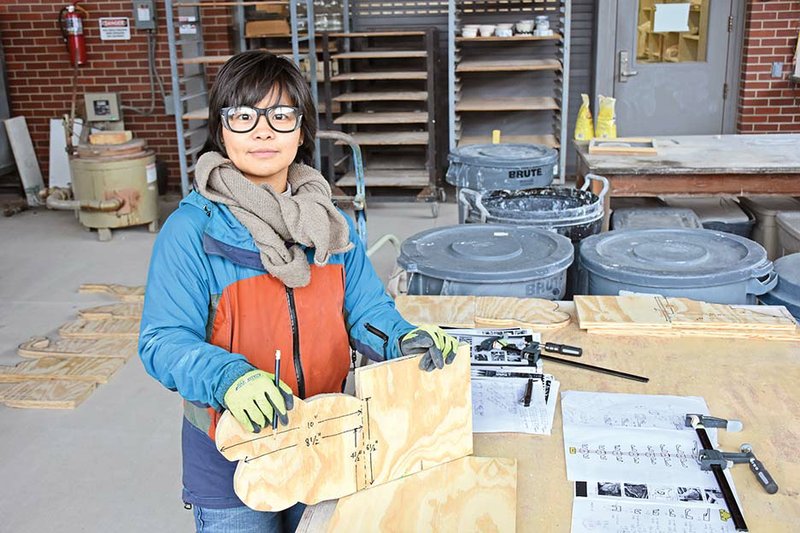RUSSELLVILLE — Although Japanese artist Manami Ishimura has been in the United States for three years, she had never been to Arkansas … until a few weeks ago. She is undertaking another first experience as well — she is the first artist in residence at Arkansas Tech University in Russellville.
“I am excited about this,” Ishimura told recent visitors to the ATU Art Department. “I came to Corpus Christi, [Texas], three years ago for school, but I had never been to Arkansas.
“Arkansas is so similar to Japan. … Japan has a lot of woods like here,” she said, smiling. “I grew up in Tokyo … a concrete jungle. I like it here.”
Ishimura will be at Arkansas Tech through May.
“We are honored to have Manami on campus this semester,” said Jeff Woods, dean of the ATU College of Arts and Humanities. “ATU received a two-year grant from the Windgate Foundation in 2018 to conduct a teacher-training program and an artist-in-residence program.”
Woods said Ishimura was selected through a competitive
application process by a committee of art-department faculty members.
“The program provides on-campus housing, a stipend and a supply budget to the artist,” he said. “The artist (Ishimura) teaches a studio course and will produce a work of public art for the ATU campus. Manami will also provide additional lectures, open studios and public workshops throughout the semester.”
Summer Bruch, associate professor and head of the art department, said, “One of the main purposes of the artist in residence program is to bring art to our campus and community.
“Manami was one of 40 artists in the international competition for the artist in residence program,” Bruch said. “She just graduated from Texas A&M University Corpus Christi in December. She will teach one class this semester and produce a piece of outdoor sculpture for the campus.
“The artist in residence program is ongoing, and Windgate has agreed to support the program through next year, along with Art Launch, our K-12 art teachers’ professional development program offered during the summer,” Bruch said. “This year’s Art Launch is June 10-13.”
Ishimura, 31, earned a Bachelor of Fine Arts degree in sculpture from Tama Art University in Tokyo, Japan, in 2012 and a Master of Fine Arts degree in sculpture from Texas A&M University Corpus Christi in December 2018.
She said that when she was a child, she liked drawing and making things, but she did not think she was going to be an artist.
“It was just because I did not think about my future, although I wanted to be multiple things … a dancer, comic author and artist as well,” she said. “I started thinking about being an artist seriously in high school.
“After I graduated with my BFA, I was trying to be an artist in Japan,” Ishimura said. “I had to work part time, too. Japan is a small country. … I knew I needed to go to an English-speaking university for my master’s degree … for a larger artist community.”
Ishimura said she had been part of a group art exhibit in Corpus Christi, so she decided to apply to Texas A&M Corpus Christi for her graduate work.
“The campus here at Tech is so beautiful … so clean,” Ishimura said. “I am teaching a 3-D design class, and I am creating a sculpture for a public art display. This is the first time for me to do public art.”
She said the public art she will create is inspired by Chinese, Japanese and Korean architectural art forms — in particular, corbels, or brackets, of roofs from these three countries.
She writes, in part, in her proposal: “China, Japan and Korea have complex relationships, with changing sovereignties, and colonial and territorial issues throughout the past 3,000 years, yet, there are common customs and similar cultures. … I propose to utilize the time and facilities at Arkansas Tech University to create a series of sculptures fostering a dialogue about the complicated and contradictory desires to unify and divide these cultural perspectives and characteristics.”
Ishimura said the piece she envisions for the campus will be 8 to 9 feet high and 5 to 6 feet wide.
“It will be tall and skinny,” she said, laughing. “It will be made of clay that is fired in a kiln. It will combine Korean, Japanese and Chinese cultures. … It will look very unified.”
Ishimura said she has not yet titled her piece of sculpture.
“I am waiting [to see] how the actual piece will be,” she said.
For her MFA thesis exhibition in Corpus Christi, which was on display in a solo exhibit in December 2018 at K Space Contemporary in Corpus Christi, Ishimura created an installation of porcelain cranes she called Sublimation.
She said the installation was inspired by a book she read about Sadako Sasaki, who was a victim of the atomic bombing of Hiroshima, Japan, on Aug. 6, 1945. Sasaki survived the bombing but died in 1955 from radiation poisoning from the atomic bomb.
Ishimura said the young schoolgirl had a “vision” to create a thousand origami cranes.
“The cranes are a hope for long life,” Ishimura said. For her thesis exhibition, Ishimura created 8,000 small porcelain cranes and installed them on the floor of the gallery.
Ishimura’s works have been included in exhibitions at the Masur Museum of Art in Monroe, Louisiana; the Wichita Falls Museum of Art at Midwestern State University in Texas; Biwako Binnale in Shiga, Japan; and Gallery C at the Tokyo Metropolitan Art Museum in Tokyo, Japan.
For more information about the ATU Department of Art, visit the website
www.atu.edu/art.
